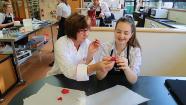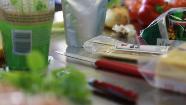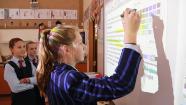With a focus on using seasonal produce and their families as stakeholders, students produced great recipes and food bags for a family dinner.
A food bag for a family dinner
Transcript
Judi Delbridge: We developed a programme based on Nadia Lim’s My Food Bag. Nadia was one of the Masterchef finalists and a person that most of our students knew about. She works with seasonal produce, things that are fresher, and she uses a system where food is delivered to the home but not cooked. So it means that the family who purchase that are still responsible for the cooking and the sharing of the food but they don’t have all that sort of thinking about what it is that they are going to make each day and they don’t do the supermarket shopping and so on for it.
We liked that model because we wanted to bring in the use of seasonal food. We wanted to bring in the ideas about people sharing the making of the food and the eating of the food as families. We also thought that it brought in a lot of those sustainability features, and we’ve got a beautiful garden where the girls could actually grow some of their produce. It also meant the girls had really genuine stakeholders. So they were using their own family, who were accessible. It meant that they were producing things that were real and it was authentic. It enabled us to have a lot of skills based work as well alongside the functional modelling and the outcome development, and the brief development.
Student: We decided to make quesadillas. We’ve modelled it once and we think that we could take out some of the beans and add some more vegetables. We put the beans in too late so it made them all dry and mushy. So we think next time we model it, we should put them in at the same time. If we put the beans in at the same time, the flavours will be more mixed and the beans won’t taste all dry and mushy.
Judi: So the girls at the end of the unit take home to their families a bag with something they’ve grown, a recipe that they’ve developed, and all the ingredients required for their family to sit or work together to create a meal.
The Food Bag project has obviously got constraints in terms of budget. We use a lot of pantry staples as the basis and we work on a budget of $15 per family. So, that’s rounded out, we may have a family of two, we may have a family of seven, but the children still take home a bag that will feed that family. We grow a lot of our vegetables and certainly our herbs and garnishes so that the girls can pick those fresh from the garden and that of course pulls the budget down a little bit.
The girls work independently to start and come up with a recipe idea and then they discuss it with their group and they trial each of the girls’ recipes, and as a group they collaborate and decide on which recipe they are going to trial further. And of course it’s got to meet the stakeholders’ needs at home, so we group the girls depending on what their survey has been and what the interviews they’ve had with their families, and so on. So the girls then test and trial several times, and then each group tests and trials someone else’s so that they can see how the students have actually worked their recipe cards and whether those instructions and the modifications and things they’ve done actually work – obviously before those things go home.
Related videos
Getting the context right (01:31)
Students, teachers, and the school community are interested and engaged in the projects and products in the technology programme, says Judi Delbridge....
Real food, real fast (02:35)
Students were set a brief to develop a faster, fresher, healthier takeaway based on an analysis of a traditional recipe....
Growing knowledge beyond students' practice (02:27)
Claire Wood and a year 8 student talk about unpacking examples of technologists' practice to grow curriculum understandings.



